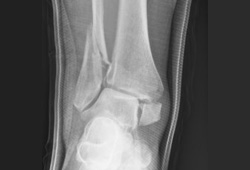Summary
Definition
History and exam
Key diagnostic factors
- recent trauma
- ankle pain and swelling
- inability to weight-bear
- medial and/or lateral malleolus swollen and tender to palpation
Other diagnostic factors
- ankle deformity
- crepitus
- tenderness of the proximal fibula
- tenting of the skin over the medial malleolus
- Ottawa ankle rules
- history of osteoporosis
- history of frequent falls
- vascular compromise
Risk factors
- low-energy fall
- osteoporosis
- multiple falls
- inversion injury to ankle
- playing sports
Diagnostic tests
1st tests to order
- plain radiograph
Tests to consider
- plain radiograph "stress view" or a standing anteroposterior radiograph
- CT
- MRI
Treatment algorithm
open fracture
closed fracture + dislocation
isolated lateral malleolar fracture
isolated medial malleolar fracture
bimalleolar/trimalleolar fracture
Contributors
Authors
Ewout S. Veltman, MD
Orthopaedic and Trauma Surgeon
Erasmus MC
Rotterdam
The Netherlands
Disclosures
ESV declares that he has no competing interests.
Rudolf W. Poolman, MD, PhD
Consultant Orthopaedic Surgeon
Joint Research
Onze Lieve Vrouwe Gasthuis
Amsterdam
The Netherlands
Disclosures
RWP has been a member of the Dutch Orthopedic Association Committee, has received grants for the ZonMW ESCAPE trial, DART trial, Achmea Escape trial and Van Rens Fonds REDEP trial, and has contributed to the following educational events: the Waldemar Link hip course and the J&J hip course.
Acknowledgements
Dr Ewout S. Veltman and Dr Rudolf W. Poolman would like to gratefully acknowledge Dr Mohit Bhandari and Dr Brad Petrisor, previous contributors to this topic, as well as Dr Victor A. van de Graaf and Dr Dirk P. ter Meulen for their assistance with the final draft. MB and BP declare that they have no competing interests.
Peer reviewers
Charles Court-Brown, MB ChB
Professor of Orthopaedic Surgery
Consultant Orthopaedic Surgeon
Edinburgh Orthopaedic Trauma Unit
Royal Infirmary of Edinburgh
Edinburgh
UK
Disclosures
CCB is an author of several references cited in this topic.
James C. Puffer, MD
Professor
University of Kentucky School of Medicine
President and Chief Executive Officer
American Board of Family Medicine
Lexington
KY
Disclosures
JCP declares that he has no competing interests.
Philip H. Cohen, MD
Clinical Assistant Professor of Medicine
Robert Wood Johnson Medical School
University of Medicine and Dentistry of New Jersey
Piscataway
NJ
Disclosures
PHC declares that he has no competing interests.
Peer reviewer acknowledgements
BMJ Best Practice topics are updated on a rolling basis in line with developments in evidence and guidance. The peer reviewers listed here have reviewed the content at least once during the history of the topic.
Disclosures
Peer reviewer affiliations and disclosures pertain to the time of the review.
References
Key articles
British Orthopaedic Association Standards for Trauma. The management of ankle fractures. Aug 2016 [internet publication].Full text
American College of Radiology. ACR appropriateness criteria: acute trauma to the ankle. 2020 [internet publication].Full text
American Academy of Orthopedic Surgeons. Prevention of surgical site infections after major extremity trauma: evidence-based clinical practice guideline. Mar 2022 [internet publication].Full text
Reference articles
A full list of sources referenced in this topic is available to users with access to all of BMJ Best Practice.

Differentials
- Lateral ankle ligament tear (anterior talofibular ligament and calcaneofibular ligament)
- Achilles tendon rupture
- Talar fracture
More DifferentialsGuidelines
- Fracture management practice guideline
- Appropriate Use Criteria: prevention of surgical site infection after high energy extremity trauma
More GuidelinesLog in or subscribe to access all of BMJ Best Practice
Use of this content is subject to our disclaimer